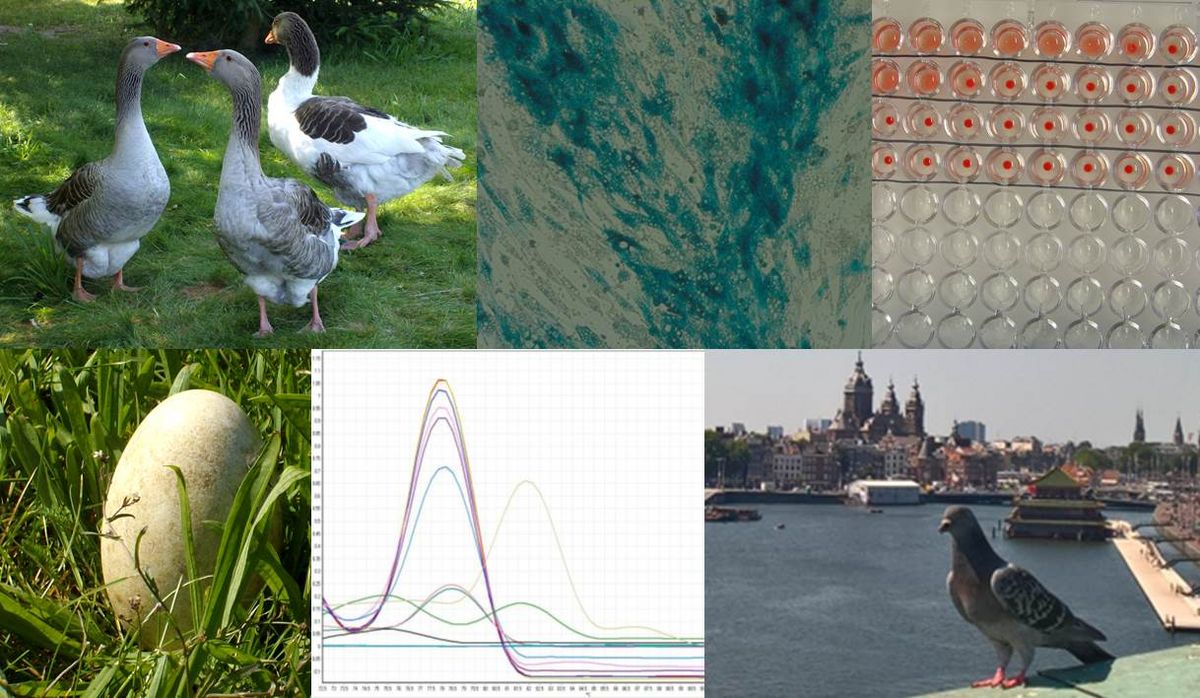A broad spectrum of viral pathogens has been described in wild and pet birds. Even productive poultry is not spared from possible viral infections. Detailed knowledge of the pathogens and their pathology is of crucial importance for the selection of suitable prophylaxis and treatment measures. At our institute, the prevalence and molecular pathogenesis of a large number of avian viruses from different families is being investigated.
Research on various virus infections in birds
Epidemiology and pathogenesis of Flavivirus infections in birds
Subject
The research project investigates the spread and pathogenesis of flavivirus infections in various bird species.
Summary
Flaviviruses belong to the group of so-called arboviruses, which means that these pathogens are transmitted by arthropods such as mosquitoes, sand flies and ticks.
Worldwide there are about 90 different flavivirus species known, some of which are of great importance in the field of human medicine (e.g. Dengue virus, Yellow fever virus and Zika virus). In the field of veterinary medicine in Germany, the Tick-borne encephalitis virus (TBEV) as well as the Usutu and West Nile viruses are of major importance.
These pathogens are mainly found in (wild) birds, but can also cause diseases in horses. Usutu viruses were first detected in mosquitoes in Germany in 2010 and were responsible for massive bird mortality in subsequent years, especially in blackbirds. Within the framework of a cooperation with the VMF's Clinic for Birds and Reptiles and the Friedrich-Loeffler-Institute in Riems, we were able to show for the first time that at least four different types of Usutu virus simultaneously circulate in Germany. Therefore, the research project aims to clarify whether there are differences between these Usutu virus types with regard to the host spectrum and their pathogenicity. In addition, extensive studies on the epidemiology of West Nile virus will be carried out as part of this work.
The project is carried out in collaboration with the Department of Birds and Reptiles and the Institute of Veterinary Pathology of the Faculty of Veterinary Medicine.
Project manager
Prof. Dr. Dr. Thomas Vahlenkamp
Participating employees
Dr. Michael Sieg
TÄ Maria Wald
Jana Schömburg
Katrin Erfurt
Cooperations
Dr. habil. Volker Schmidt, Klinik für Vögel und Reptilien, VMF, Universität Leipzig
PD Dr. rer. nat. habil. Claudia Claus, Institut für Virologie, Universität Leipzig
Funding
Dres. Jutta & Georg Bruns - Foundation
Publications
Michel, F., Sieg, M., Fischer, D., Keller, M., Eiden, M., Reuschel, M., … & Ziegler, U. (2019). Evidence for West Nile Virus and Usutu Virus Infections in Wild and Resident Birds in Germany, 2017 and 2018. Viruses, 11(7), 674.
Sieg, M., Schmidt, V., Ziegler, U., Keller, M., Höper, D., Heenemann, K., ... & Vahlenkamp, T. W. (2017). Outbreak and cocirculation of three different Usutu virus strains in eastern Germany. Vector-Borne and Zoonotic Diseases, 17(9), 662-664.
Prevalence study of pigeon Rotavirus group A
Subject
The research project contributes to the understanding of newly described disease outbreaks in pigeons after rotavirus infections.
Summary
In 2016, Australian carrier pigeons developed a disease of unknown origin that led to reduced performance and high mortality rates due to hepatitis. Further investigation revealed that the disease was associated with a novel avian rotavirus. Infections with various rotaviruses cause acute viral gastroenteritis in humans, but also in other mammalian and avian species. Infections are usually confined to the gastrointestinal tract and are self-limiting, although deaths from dehydration can occur, especially in younger animals. In contrast, the newly described group A pigeon rotavirus has been shown to cause systemic infections leading to clinical symptoms such as apathy, fluffy plumage, loss of appetite, vomiting, congested goiter, emaciation and diarrhoea. Breeders often reported disease outbreaks in pigeon lofts after participating with their animals in shows. We therefore investigated the presence of group A pigeon rotavirus in animals presented at shows and compared these results with the clinical symptoms observed in the affected animals.
Project manager
Prof. Dr. Dr. Thomas Vahlenkamp
Participating employees
Dr. Antje Rückner
TÄ Maxi Harzer
Publication
Harzer, M., Heenemann, K., Sieg, M., Vahlenkamp, T., Freick, M., & Rückner, A. (2020). Prevalence of pigeon rotavirus infections: animal exhibitions as a risk factor for pigeon flocks. Archives of Virology, 1-8.
